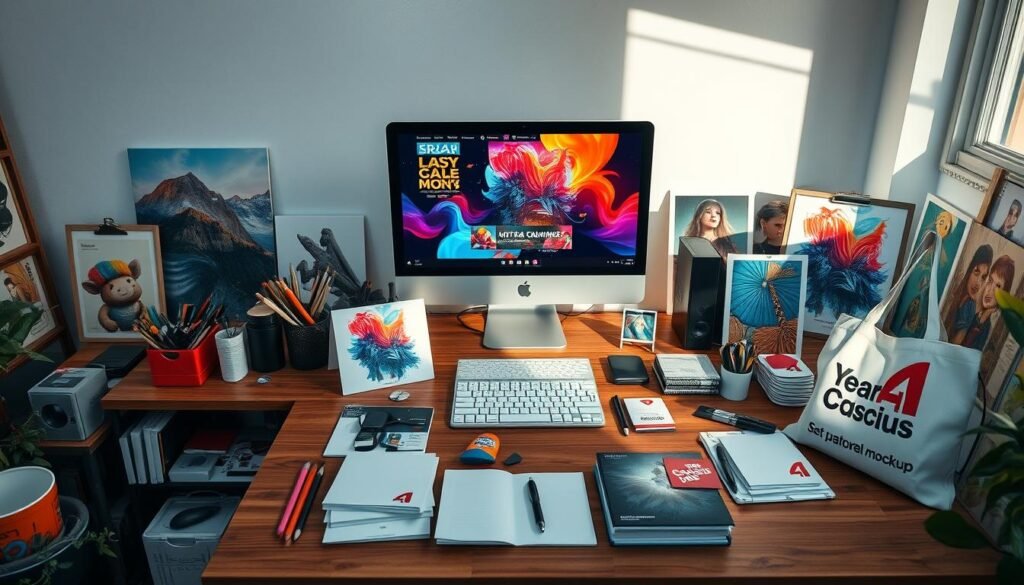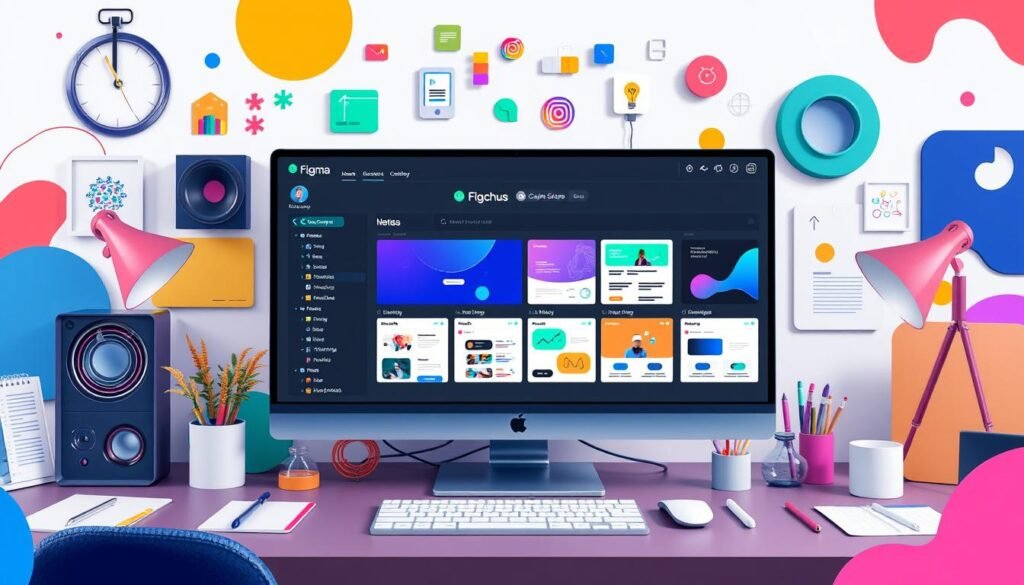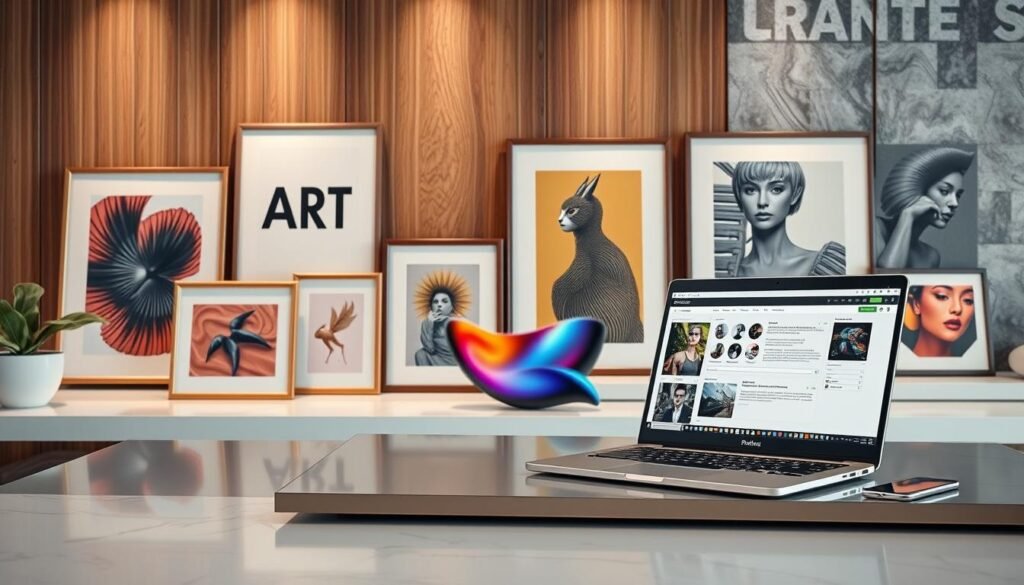As a passionate visual designer, I understand the value of creating engaging mockups. These designs are key in the graphic design world. They help us show our work in a professional and eye-catching way. Here, I’ll share my knowledge and practical tips on mastering mockup design. This will help you improve your work and impress your clients.

Key Takeaways
- Understand the fundamental elements of professional mockup design
- Explore different types of mockup styles and their applications
- Discover the essential tools and software for creating stunning mockups
- Learn techniques for achieving photorealistic results in your mockups
- Implement responsive design principles to ensure your mockups adapt seamlessly
Understanding the Fundamentals of Mockup Design
Mockup design is key in the creative process. It connects the idea stage to the final product. Designers use mockups to share their vision, improve ideas, and get feedback from others.
At the core of good mockup design are several important elements. Every designer should know these to succeed.
Key Elements of Professional Mockups
Prototyping and wireframing are the base of professional mockups. They help designers test layouts, functions, and user experience without a final design. Details like typography, color, and images are also crucial for engaging mockups.
Different Types of Mockup Styles
Mockup designs vary, each for a specific use. From static UI/UX mockups to interactive prototypes, the right style depends on the project and designer’s goals. Trying out different styles helps designers find the best way to share their ideas.
The Role of Mockups in Design Process
Mockups are essential in the design process. They let designers test and improve ideas before the final product. Through mockups, designers get feedback, spot problems, and make better decisions.
This back-and-forth process ensures the design meets the client’s and user’s needs.
“Mockups are the cornerstone of effective design communication. They allow us to bring our ideas to life and refine them until we’ve achieved the perfect solution.”
Essential Tools and Software for Creating Stunning Mockups
As a graphic designer, I’ve found that the right tools and software are key. Adobe XD and Figma are two top choices that help me create amazing mockups. They offer many features that let me bring my ideas to life.
Adobe XD is great for designing user interfaces and experiences. It’s easy to use, has strong prototyping tools, and works well with other Adobe apps. With it, I can make detailed mockups, test interactive designs, and get feedback from others.
Figma is a cloud-based platform that’s popular among designers. It’s perfect for teamwork because it lets us work together in real-time. It also has version control and works on different devices. This means my designs look good everywhere.
There are many other tools and software for making great mockups. For example, Adobe Illustrator is great for vector graphics, and Adobe Photoshop is perfect for photo editing. The graphic design world has lots of options to help designers create amazing mockups.
“The right tools can empower designers to transform their ideas into captivating visual experiences.”
Choosing the right tools depends on the project’s needs, the team’s preferences, and how detailed you want the mockup to be. Using Adobe XD and Figma can help designers make their mockups stand out. This shows off their skills and creativity.
Getting Started with Adobe XD for Mockup Creation
Adobe XD is a key tool for UI/UX designers. It’s easy to use and great for making mockups. Here, I’ll show you how to get started and use its basic features.
Setting Up Your Workspace
Begin by setting up your workspace in Adobe XD. You can pick from various artboard sizes or make your own. You can also adjust settings to make your work easier.
Basic Features and Functions
Adobe XD has many tools to help you create mockups. You can use simple tools or advanced vector drawing. The prototyping feature lets you add interactions and animations.
Creating Custom Templates
Creating custom templates in Adobe XD saves time. You can make color palettes, typography styles, or layouts. This helps you keep your designs consistent and professional.
Adobe XD is a top choice for UI/UX designers. It’s easy to use and has powerful features. Whether you’re new or experienced, it’s a valuable tool for prototyping.
Leveraging Figma for Collaborative Mockup Projects
Figma is a game-changer for designing stunning mockups. It’s a top UI/UX design tool with features perfect for teams on complex projects.
Figma shines with its real-time collaboration. Teams can work on the same mockup file, sharing feedback and updates instantly. This keeps everyone in sync, cutting down on design project delays.
Figma’s prototyping features are also key. Designers can turn static mockups into interactive prototypes with a few clicks. This lets clients see the design in action, helping to get approvals.
Additionally, Figma’s versioning and commenting system is robust. It helps track changes, manage feedback, and keep a clear design history. This is great for large teams or clients who need transparency.

Figma also comes with pre-built UI kits and templates. These save time and ensure design consistency across projects.
Whether you’re solo or part of a team, Figma’s tools can help you create amazing mockup projects. These projects will impress clients and stakeholders alike.
Color Theory and Typography in Mockup Design
As a graphic designer, I’ve learned that color and typography are key. They can make or break a mockup’s visual impact. Mastering these elements is crucial for creating designs that truly captivate.
Choosing the Right Color Palette
The colors you choose can convey strong emotions and set the tone. Understanding color theory helps you pick a cohesive palette. Try different shades and hues to add depth to your designs.
Typography Principles for Visual Impact
Typography is vital in mockup design. The right fonts, sizes, and pairings can improve readability and look. Follow best practices for headings, line spacing, and contrast to enhance your designs.
| Color Palette Considerations | Typography Principles |
|---|---|
| Color theory (complementary, analogous, triadic) Mood and emotion Branding and identity Accessibility and contrast | Font selection and pairings Hierarchy and readability Line spacing and alignment Contrast and emphasis |
Mastering color and typography in mockup designs can elevate your visual design. It strengthens your branding and leaves a lasting impression on your graphic design audience.
“Effective color and typography can transform a good design into a great one.”
Creating Realistic Product Mockups
As a professional designer, creating lifelike product mockups is key. It shows my designs in a way that grabs attention. This skill is vital for sharing my ideas and getting client approval.
To make my designs come alive, I use various techniques. These include textures, materials, and lighting. By digitally recreating these, I let clients see the real product. This way, they can truly understand my work.
Attention to detail is crucial in making mockups look real. I focus on every part of the product, from patterns to shadows. This focus ensures my mockups are not just pretty but also true to the final product.
| Technique | Description |
|---|---|
| Texture Mapping | Accurately applying realistic textures and materials to the product’s surfaces, such as wood grain, metal finishes, or fabric patterns. |
| Lighting Simulation | Recreating natural and artificial lighting conditions to cast shadows, highlights, and reflections that enhance the product’s realism. |
| Perspective Rendering | Utilizing perspective and camera angles to showcase the product in a realistic, three-dimensional space. |
By perfecting these techniques, I create mockups that wow my clients. These mockups showcase my product design, mockup design, and visual design skills. The realism helps clients see the final product clearly, bridging the digital and physical worlds.
“The quality of a product mockup can make or break a client’s decision. Investing time and effort into creating realistic, visually stunning mockups is essential for success in the design industry.”
Mastering UI/UX Mockups for Digital Products
As a designer, making great UI/UX mockups is key to bringing digital products to life. Whether it’s a mobile app or a website, this phase lets you show off your creativity and focus on the user. We’ll look at the best ways to make mobile app mockups and how to create effective website mockups.
Mobile App Mockup Best Practices
For mobile app mockups, detail matters a lot. First, understand who your users are and what they need. Use user research and wireframes to make interfaces that are easy to use. Include important UI elements like navigation and menus for a smooth experience.
Also, focus on how your app looks. Use ui/ux design to make it look good and appealing. Try out different fonts, colors, and images to make your app stand out and match your brand.
Website Mockup Techniques
Website mockups need a different approach than mobile apps. Start with a clear layout and wireframes that guide users. Try different layouts, navigation, and content organization to improve the user experience.
Use prototyping tools to make your website mockups interactive. This lets users see how the website works and find any problems early. It helps make sure the website is easy to use and fun to explore.
| Mobile App Mockups | Website Mockups |
|---|---|
| Focus on user-centric design Incorporate essential UI elements Attention to visual aesthetics | Establish clear information architecture Experiment with layout and navigation Utilize prototyping tools |
By getting good at making UI/UX mockups, you can share your design ideas clearly. This ensures your digital products are easy and enjoyable to use.
Branding and Identity Mockup Strategies
As a graphic designer, I know how important branding and visual identity are. Creating mockups that show these elements is key. We’ll look at ways to make branding and identity mockups that grab your clients’ attention and boost your branding, visual design, and graphic design services.
Creating impactful mockups means matching the client’s brand with their values. You need to pick colors, fonts, and layouts that speak to the audience and reflect the brand’s message.
- Use branding guidelines and mood boards to guide your design choices.
- Try out different graphic design styles, like simple or bold, to make your mockups pop.
- Add visual design elements like icons or patterns to make the mockups more appealing and cohesive.
It’s also crucial to show the design in a real-world setting. By placing logos and business cards in context, you help clients see how their brand will look and feel in action.

“The best branding is built on authenticity, not artifice. It’s about connecting with your audience in a genuine, meaningful way.”
The aim of your branding and identity mockups is to impress and communicate your clients’ brand essence. By mastering these strategies, you can enhance your design portfolio and become a reliable partner in branding, visual design, and graphic design.
Advanced Techniques for Photorealistic Mockups
Making mockups look real is an art. As a product design expert, I’ve learned to create stunning mockups. I focus on lighting, shadows, textures, and materials to make them look real.
Lighting and Shadow Effects
Getting lighting right is key for a real visual design feel. I study different light sources to use in my mockup design. I adjust light intensity, direction, and color to add depth and realism.
Texture and Material Rendering
Bringing surfaces to life is crucial. I’ve learned to capture the details of textures, from glass to concrete. By simulating material properties, my mockups feel real and tangible.
“Mastering the art of photorealistic mockups is like weaving a spell – you transport your audience into a world that feels entirely real, yet truly your own.”
Understanding lighting, shadows, textures, and materials helps me create amazing mockup design. My work captivates clients with its realism.
Responsive Design in Mockup Creation
In today’s digital world, making mockups that work on all devices is key. As a UI/UX designer, I’ve found that responsive design is essential. It makes sure users have a great experience, no matter the screen size.
When making mockups, I think about the different sizes and resolutions of devices. Using responsive design, I keep my ui/ux prototypes and wireframes looking good and working well on various platforms.
Mastering Responsive Mockup Design
To make responsive mockups, I start with a solid grid system. This helps my designs fit well on any screen. I also focus on typography, making sure text is easy to read on all devices.
Flexible media, like images and videos, are also key. They help my mockups look great on different screens without losing quality.
| Device | Screen Size | Resolution | Aspect Ratio |
|---|---|---|---|
| Smartphone | 4.7 – 6.7 inches | 1080 x 2340 pixels | 19.5:9 |
| Tablet | 7.9 – 12.9 inches | 2048 x 1536 pixels | 4:3 |
| Desktop | 13 – 27 inches | 1920 x 1080 pixels | 16:9 |
By considering these device details, I make ui/ux mockups that fit many screen sizes and resolutions. This ensures a responsive and user-friendly design experience.

“Responsive design is not just a technical requirement, but a fundamental principle of user-centered design. It’s about ensuring that our digital experiences are accessible, engaging, and consistent across all touchpoints.”
Prototyping and Interactive Mockups
In the world of design, prototyping and interactive mockups are key. They help us bring our ideas to life. As a UI/UX pro, I see how these prototypes show my work and give insights into user interaction.
Adding Animation and Transitions
Prototyping lets us add animation and smooth transitions. This makes the user experience more immersive and engaging. I use tools like Adobe XD to explore animation options and bring designs to life.
User Testing with Interactive Mockups
Interactive mockups are powerful for user testing. They let us get feedback from potential users. This feedback helps us refine our prototyping and make informed design choices.
Improving my prototyping skills is essential. Interactive mockups give us valuable insights. They help us create designs that are not only beautiful but also user-friendly. This is a critical part of my ui/ux design process.
Common Mockup Design Mistakes to Avoid
As a graphic designer, I’ve learned that making great mockup designs is key. It helps show off your work and impress clients. But, even experienced designers can make common mistakes. Here, I’ll talk about some common errors and how to avoid them.
One big mistake is being inconsistent. It’s important to make sure everything looks the same, from text to colors. If your design doesn’t match, it can hurt your overall look.
- Keep your style the same in all your mockups
- Make sure text, images, and design elements work well together
- Use the same colors and fonts everywhere
Another mistake is making your designs look too good to be true. Mockups should really show what the final product will look like. If they look too perfect or fake, it can confuse clients and make them doubt your work.
- Try to make your mockups look as real as possible
- Don’t use too many filters or edits that make things look fake
- Make sure the size, view, and setting of your mockup are correct
Finally, not paying attention to small details can ruin your design. Little things like how things are lined up or the quality of images can make your design look unprofessional.
| Common Mockup Design Mistakes | Effective Solutions |
|---|---|
| Inconsistent branding and design elements | Maintain a cohesive style and alignment throughout |
| Unrealistic or exaggerated product representations | Strive for photorealistic mockups that accurately reflect the final product |
| Lack of attention to detail in alignment, spacing, and image quality | Meticulously review your mockups for any overlooked elements |
By avoiding these mistakes, you can improve your mockup design skills. This will help you create professional-looking presentations that show off your design skills and grab your clients’ attention.

“The devil is in the details when it comes to creating effective mockups. Pay close attention to every element to ensure a seamless, professional presentation.”
Presenting Your Mockups to Clients
As a pro in branding, product design, and visual design, presenting mockups to clients is key. How you show your designs can really impact getting client approval and moving projects ahead.
When showing mockups, it’s important to balance the visual appeal with the strategic thinking behind your designs. Here are some tips to help you do this:
- Tell a Story: Show the mockups and tell a story about the design process. Explain how you got to the final concept and how it fits with the client’s brand or product goals.
- Focus on Benefits: Talk about how the mockup will help the client’s business. This could be better user experience, stronger brand recognition, or more sales.
- Invite Feedback: Ask for the client’s thoughts and be open to their ideas. Show you’re ready to work together and use their feedback in the design.
- Use Visuals Strategically: Use great visuals like product shots and animations to make your designs stand out and grab the client’s interest.
- Highlight Unique Selling Points: Point out what makes your mockups special. Show your expertise and creative approach.
Mastering mockup presentation can impress clients, build trust, and encourage teamwork. It’s a key step in getting your branding, product design, and visual design work approved.
| Key Elements | Best Practices |
|---|---|
| Storytelling | Guide clients through the design process and explain the rationale behind the mockups. |
| Highlighting Benefits | Demonstrate how the mockups will deliver tangible value to the client’s business. |
| Inviting Feedback | Actively seek the client’s input and incorporate their suggestions into the design. |
| Strategic Visuals | Use high-quality visuals, animations, and product shots to bring the mockups to life. |
| Unique Selling Points | Emphasize the distinctive features or qualities that set your mockups apart from the competition. |
“Effective mockup presentation is not just about showcasing your design skills; it’s about building trust, fostering collaboration, and ultimately, securing client approval for your work.”
Conclusion
Mastering mockup design is key for graphic designers and UI/UX pros. Knowing the basics, using the right tools, and following best practices can make your designs stand out. This helps win over your clients.
Creating beautiful product mockups and UI/UX prototypes is crucial. The tips in this article will help you present your work in the best way. High-quality mockups can greatly impact how your designs are seen and their success.
Now, apply what you’ve learned. Try out different mockup styles and the latest design software. Keep improving your attention to detail and taste. With hard work and a desire to learn, you’ll excel in mockup design. This will boost your career in graphic design and UI/UX.
FAQ
What is the significance of mastering mockup design?
Mastering mockup design is key for showing off your artwork and design work. Good mockups grab clients’ attention and highlight your designs’ best features. They make your work stand out in a crowded field.
What are the essential elements of professional mockups?
Professional mockups need to show products realistically and accurately in size. They must also focus on details like textures and materials. Plus, they should show how the product will be used.
What are the different types of mockup styles I can use?
You can try out many mockup styles. These include product shots, lifestyle mockups, flat lay compositions, and mockups for digital products like apps and websites.
How do mockups fit into the overall design process?
Mockups are vital in the design process. They connect initial ideas to the final product. They help with quick visual checks, making changes, and talking to clients.
What are the top tools and software for creating high-quality mockups?
Top tools like Adobe XD and Figma are great for mockup design. They offer features for prototyping, UI/UX design, and working together. These tools make creating mockups easier.
How can I leverage Adobe XD for my mockup design needs?
Adobe XD has many tools for mockup design. You can set up your space, use artboards and components, and make custom templates. This helps your workflow and makes your mockups look better.
What are the benefits of using Figma for collaborative mockup projects?
Figma is great for team projects because of its collaboration features. It lets you get feedback, make changes, and keep track of versions. This makes working together smooth and project management easy.
How do color theory and typography principles influence mockup design?
Choosing colors and typography wisely can make your mockups look better. Knowing about color theory and typography can help you create mockups that look good and are professional.
What techniques can I use to create realistic product mockups?
To make product mockups look real, focus on textures, materials, and lighting. Paying attention to these details can make your digital mockups look lifelike.
What best practices should I follow for UI/UX mockups of digital products?
For UI/UX mockups, follow user experience design principles. This means making navigation easy, layouts responsive, and visuals consistent. Special techniques for apps and websites can show how users will interact with your product.
How can I create mockups that effectively showcase branding and identity designs?
To show off branding and identity, use smart techniques. Place products in context, use consistent brand elements, and focus on visual details. This helps your brand’s identity and personality shine through.
What advanced techniques can I use to achieve photorealistic mockups?
For realistic mockups, master lighting, shadow, texture, and material rendering. These skills can make your digital presentations look professional and lifelike.
How can I ensure my mockups are responsive and adaptable to different devices?
To make mockups work on all devices, focus on responsive design. Understand the principles and use the right tools. This ensures your mockups look good on any screen.
What are the benefits of creating interactive mockups and prototypes?
Interactive mockups and prototypes show off dynamic experiences. They help clients understand, allow for testing, and lead to better design improvements. This makes the design process more effective.
What are some common mistakes to avoid in mockup design?
Avoid mistakes like inconsistent visuals, unrealistic products, poor details, and not following brand or user experience guidelines. Being aware of these can help you create better mockups.
How can I effectively present my mockups to clients?
When showing mockups to clients, explain your design choices and highlight key features. Be ready to take feedback. A collaborative approach can help clients understand and value your work.




